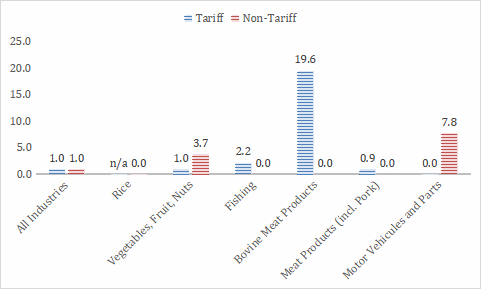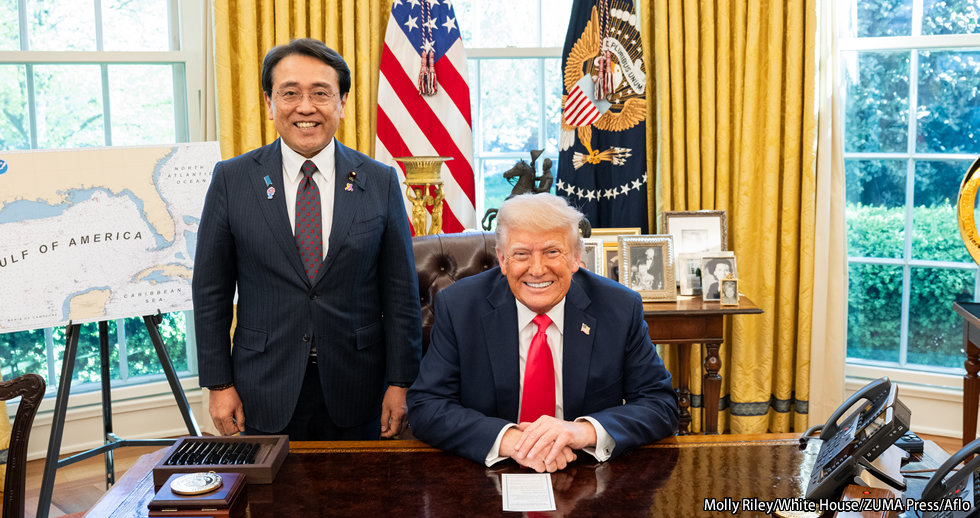Papers in the "JIIA Strategic Commentary Series" are prepared mainly by JIIA research fellows to provide commentary and policy-oriented analyses on significant international affairs issues in a readily comprehensible and timely manner.
In less than three months after taking office, US President Donald Trump rapidly introduced a series of tariff measures through executive orders. On March 12, 2025, invoking Section 232 of the Trade Expansion Act on national security grounds, he imposed an additional 25% tariff on imports of steel and aluminum from all countries. On April 3, a similar 25% tariff was imposed on imports of automobiles and auto parts from around the world, again under Section 232. Furthermore, on April 2, President Trump announced the introduction of a "reciprocal tariff" system, under which a uniform 10% tariff would be applied to all countries and regions, with additional rates imposed on 57 economies with large trade deficits with the United States. The reciprocal tariff, also justified on national security reasons, was implemented by declaring a national emergency under the President's authority and imposing tariffs based on the International Emergency Economic Powers Act (IEEPA).
The logic behind these measures is that non-reciprocal tariff rates and non-tariff barriers by U.S. trading partners have led to large and persistent trade deficits, contributing to the hollowing-out of U.S. manufacturing and weakening supply chains, thereby threatening national security. The 57 targeted economies include China, the EU, India, Indonesia, the Philippines, South Korea, Taiwan, and Japan, with Japan facing a tariff rate of 24%. The base 10% tariff was implemented on April 5. In response to Chinese retaliatory measures, the U.S. further raised tariffs on China to 125%, resulting in an effective rate of 145% when combined with existing tariffs. China responded by imposing retaliatory tariffs up to 125% on U.S. goods. However, for the other 56 countries and regions, the U.S. offered a 90-day grace period starting April 9, during which tariffs were reduced back to 10%, citing progress in negotiations.
The stated objectives of the reciprocal tariffs are to eliminate the trade deficit, revive domestic manufacturing, and generate revenue to fund tax cuts--longstanding goals of President Trump. In his April 2 speech announcing the tariffs, Trump even declared the day "Liberation Day." On the other hand, global concerns about the economic fallout of the tariffs have triggered market turmoil, including plunging stock prices and a sharp drop in the U.S. dollar due to a sell-off in U.S. Treasuries--dubbed the "Trump Shock." Under such circumstances, the President has repeatedly revised the tariff rates in a short span of time, appearing to adjust policy frequently.
There are growing doubts about how long such unprecedented and extensive tariff measures by the world's largest economy can be sustained. Strong opposition from U.S. industry groups has already emerged, particularly against the automobile tariffs. On April 29, the administration announced tariff relief on auto parts for manufacturers that produce vehicles in the U.S. As of April 23, twelve U.S. states had filed lawsuits at the U.S. Court of International Trade seeking an injunction against the tariffs. The 100%+ tariffs imposed between the U.S. and China are nearly equivalent to an embargo and may sever bilateral trade entirely. Eliminating "Made in China" goods from the U.S. market is likely impossible, and China too would suffer severe economic consequences. President Trump has since softened his tone, stating on April 22 that tariffs on China could be "substantially reduced" and that he would not take an "overly tough stance." This suggests that the Trump tariffs are largely being used as a bargaining tool in trade negotiations. Currently, Japan, the United Kingdom, India, and Vietnam have all begun trade talks with the United States.
From April 16 to 17, Mr. Ryosei Akazawa, Japan's Minister for Economic Revitalization, visited the U.S. as the lead negotiator in Japan-U.S. talks, holding meetings with President Trump, Treasury Secretary Scott Bessent, and Commerce Secretary Howard Lutnick. According to media reports, the U.S. expressed its desire to eliminate the trade deficit and raised issues based on the USTR's Report on Foreign Trade Barriers, such as revising Japan's auto safety standards and expanding market access for agricultural products like rice, meat, seafood, and potatoes. While the U.S. goal of a zero trade deficit has been a consistent talking point since Trump's first administration, it remains unclear how seriously this goal is being pursued. Reportedly, the U.S. also raised the issue of increasing Japan's defense burden. On the other hand, Minister Akazawa stated that the topic of exchange rates was not discussed. However, the Chair of the Council of Economic Advisers, Mr. Miran, had previously noted in a report the "Mar-a-Lago Agreement," which cited dollar appreciation as a cause of the trade deficit, suggesting exchange rates could eventually come into play.
The focal points of the Japan-U.S. negotiations are the reduction of tariff and non-tariff trade barriers. The U.S. calculates reciprocal tariff rates based on the formula: Tariff Rate = (Exports − Imports) ÷ Imports. As has been widely criticized, this formula has no direct correlation with tariff levels and cannot justify the 24% tariff imposed on Japan. In reality, Japan's trade barriers with the U.S. are already low. Under the Japan-U.S. Trade Agreement that entered into force in 2020, tariffs on agricultural products, beef, and pork have been reduced to levels equivalent to the TPP (see Figure 1). According to tariff databases from the World Bank and UNCTAD, Japan's average ad valorem equivalent (AVE) tariff rates are approximately 1% across all industries, with non-tariff barriers also around 1%.1
Rice tariffs are around 341 yen/kg--equivalent to roughly 400% ad valorem2 excluding the duty-free minimum access quota--but imports from the U.S. fall under this duty-free quota. Tariffs on vegetables and seafood are low (1-2%), with non-tariff barriers at about 3% for vegetables and 0% for seafood. Tariffs on U.S. beef are scheduled to fall from 21.6% in April 2025 to 9% by 2033 under the Japan-U.S. agreement. Pork and other meats also benefit from low tariff rates under the agreement's preferential terms. Tariffs on autos and auto parts were eliminated in 1978, now standing at 0%. Non-tariff barriers on autos remain relatively high at around 8%.
Figure 1: Japan's AVE Tariff and Non-Tariff Rates on U.S. Imports

Note: All Industries are weighted average using import value.
Source: WITS (World Bank and UNCTAD), World Bank Data Catalog
With regard to rice, it was excluded from the Japan-U.S. Trade Agreement. However, during the TPP negotiations, Japan agreed to establish a special quota of 50,000-70,000 tons for U.S. rice outside the minimum access quota. According to media reports, the Japanese government is considering increasing imports of U.S. rice within the minimum access quota. Given the recent domestic rice shortages and rising prices in Japan, as well as the fact that rice was a leftover issue in the previous agreement, introducing a special quota may be a meaningful option. In addition, LDP Secretary-General Moriyama has indicated that Japan may expand imports of U.S. soybeans and corn.
Regarding automobiles--a high priority issue for the negotiation--the U.S. has raised concerns about non-tariff barriers to entry into the Japanese auto market. These include the non-recognition of U.S. auto safety standards (FMVSS) as equivalent to Japan's, difficulties in establishing distribution and service networks, and disparities in subsidies for electric vehicles (EVs) and fuel cell electric vehicles (FCEVs), as well as different charging standards and insufficient highway infrastructure. During the TPP negotiations, the U.S. and Japan exchanged non-binding letters of intent on auto safety and distribution. Japan committed to mutual recognition of equivalent or superior safety standards, harmonization with international standards, faster approval processes, and ensuring fair competition through investigations by the Japan Fair Trade Commission. Japan may need to demonstrate continued willingness to reduce non-tariff barriers in the automotive sector by following up on these TPP-era commitments.
As for currency issues, no mention was made by the U.S. side during the April 24 meeting between Finance Minister Katsunobu Kato and Treasury Secretary Bessent, according to media reports. However, President Trump has repeatedly expressed dissatisfaction with the strong dollar and concern over currency manipulation. The U.S.-Mexico-Canada Agreement (USMCA) was the first trade deal to incorporate macroeconomic and currency provisions. Although the TPP did not include binding currency clauses, a joint statement was issued prohibiting competitive devaluation, requiring regular publication of foreign exchange and balance of payments data, and mandating annual macroeconomic dialogue. This joint statement was not carried over into the CPTPP. Japan could consider issuing a similar joint statement in conjunction with the Japan-U.S. Trade Agreement.
Regarding domestic procedures in the U.S., trade agreements generally require Congressional approval. However, the previous Japan-U.S. agreements (including the Digital Trade Agreement) were concluded without Congressional involvement by utilizing the 2015 Trade Promotion Authority (TPA), which delegated negotiation authority to the President. The TPA has since expired, and President Trump tends to avoid negotiations with Congress. As such, his leverage in trade talks now consists solely of Section 232 tariffs and reciprocal tariffs. Japan should seek reductions in reciprocal tariffs and demand that the U.S. honor its commitment not to impose import restrictions under Section 232 or similar measures while the Japan-U.S. agreement is in force. A key objective will be to offer concessions in areas where President Trump can claim political wins, while pressing for substantial tariff reductions and eliminations. Given the strong backlash to Trump's tariff policy both domestically--from business groups, Congress, and financial markets--and internationally, time may not be on the U.S. side. With the 2026 midterm elections approaching, he may seek quick wins in negotiations with a reliable partner like Japan. Japan should leverage this opportunity strategically. At the same time, any outcome must remain consistent with the Japan-U.S. trade framework and the rules-based multilateral trading system centered on the WTO.



